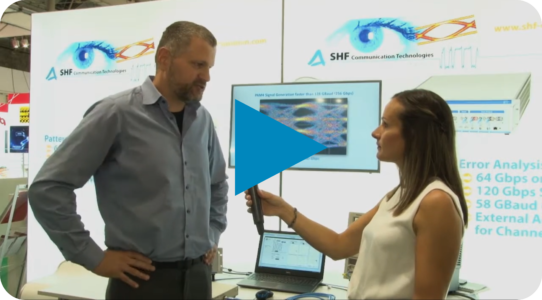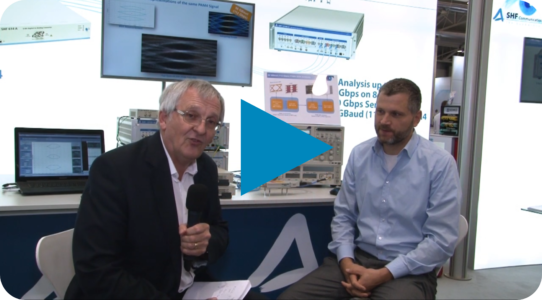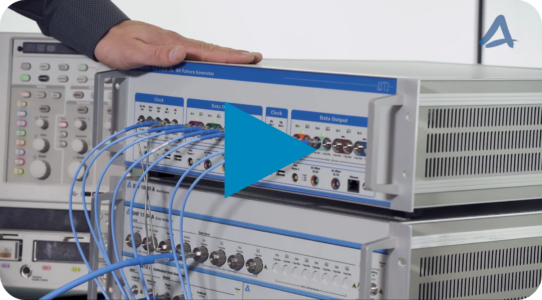Bit Error Test & Arbitrary
Waveform Generation
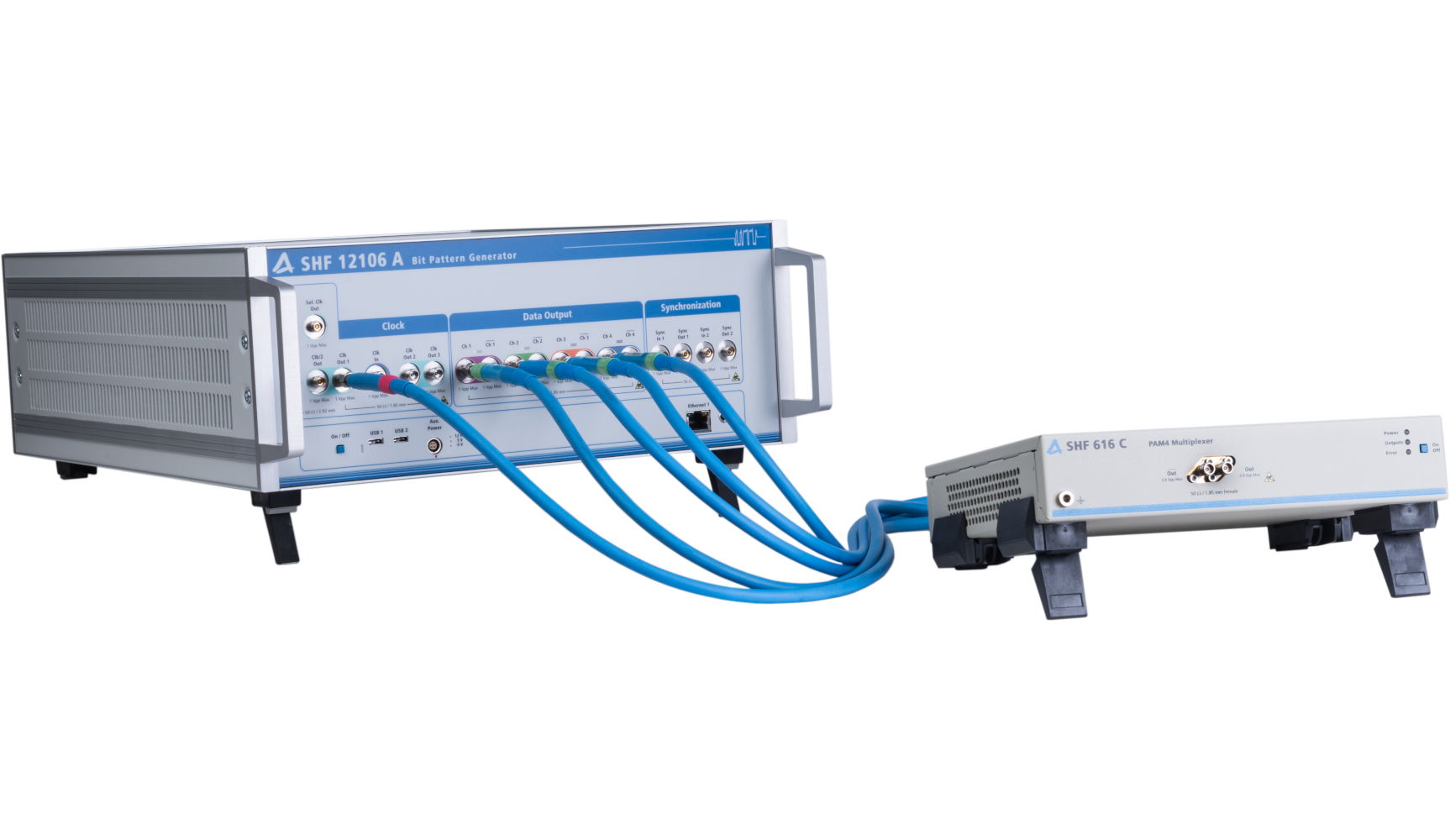
NRZ and PAM BPG
NRZ and PAM EA
AWG
Support
NRZ and PAM Pattern Generators (BPG)
SHF’s BPG instruments support a vast number of speeds, signal types and channel configurations. By extending the binary generators with our remote heads the data rate, the number of levels or both is increased.
Just load the full data sheet by clicking the product number.
| wdt_ID | BPG | Remote-Head | Remote-Head Type | Focus Application | Max. Baud Rate | Max. Channels | Capabilities |
|---|---|---|---|---|---|---|---|
| 2 | SHF 12106 A | NRZ up to 60/64 Gbps | 64.0 | 4 | - NRZ up to 64 Gbps per channel - 1, 2, or 4 channel configuration - Ideal source for SHF remote-heads - Synchronization of multiple systems |
||
| 4 | SHF 12106 A | SHF 616 C | PAM-MUX | PAM4 up to 256 Gbps | 128.0 | 1 | - PAM4 up to 256 Gbps per channel - NRZ up to 128 Gbps per channel - Synchronization of multiple systems |
| 6 | SHF 12106 A | SHF C911 A | 67 | 4-Bit DAC | PAM4 up to 120/128 Gbps | 64.0 | 2 | - PAM-X with up to 64 GBaud - E.g. 128 Gbps PAM4 per channel - E.g. 64 Gbps NRZ per channel - Synchronization of multiple systems |
| 9 | SHF 12106 A | SHF C603 B | MUX | NRZ up to 120/128 Gbps | 128.0 | 2 | - NRZ up 128 Gbps per channel - 1 or 2 channel configuration - Synchronization of multiple systems |
| 10 | SHF 12124 B | NRZ up to 32 Gbps | 32.0 | 2 | - NRZ up to 32 Gbps per channel - 2 channel configuration - Both channels are synchronized |
||
| 11 | SHF 12125 B | NRZ up to 60/64 Gbps | 60.0 | 1 | - 1 NRZ channel up to 60 Gbps - Plus 2 NRZ channles up to 32 Gbps |
||
| 16 | SHF 12126 A | PAM4 up to 64 Gbps | 32.0 | 1 | - 1 PAM4 channel up to 32 GBaud (64 Gbps) - Plus 2 NRZ channles up to 32 Gbps |
||
| 17 | SHF 19120 C | NRZ up to 12.5 Gbps | 12.5 | 4 | - 4 NRZ channels up to 12.5 Gbps - Additional AWG outputs (2.85 GSa/s) |
NRZ and PAM Error Analyzers (EA)
By combining the SHF 11104 A EA with a SHF 11221 A DEMUX, the serial data rate is extended up to 120 Gbps per channel. The SHF 11220 A PAM-Sampler enhances the capability for true PAM4 BER measurements up to a speed of up to 58 GBaud PAM4 (112 Gbps).
Just load the full data sheet by clicking the product number.
| wdt_ID | PN | Remote-Head | Remote-Head Type | Max. NRZ Data Rate | Max. PAM4 Baud Rate | Required Mainframe | Application Examples |
|---|---|---|---|---|---|---|---|
| 4 | SHF 11104 A | 64 | 32 | SHF 10001 C | NRZ up to 64 Gbps and PAM4 up to 32 GBaud (64 Gbps) | ||
| 16 | SHF 11104 A | SHF 11221 A | DEMUX | 120 | 32 | SHF 10001 C | NRZ up to 120 Gbps |
| 17 | SHF 11104 A | SHF 11220 A | PAM-Sampler | 64 | 58 | SHF 10001 C | PAM4 up to 58 GBaud (116 Gbps) |
Arbitrary Waveform Generators (AWG)
SHF is offering a cost effective solution housed in a small and light weight chassis (the SHF 19120 C) and a solution based on our BPG-DAC combination. For PAM signals, it is faster than any other AWG instrument as it samples only one single time per each bit. Thus the baud rate of the resulting PAM signal is as fast as the sample rate of the system.
Just load the full data sheets by clicking the product number.
| SHF 19120 C AWGs are in stock and ready to be shipped within a short turnaround time. |
| wdt_ID | AWG / BPG | Remote Head | Channels | Sample Rate | Vertical Resolution | Sample Memory |
|---|---|---|---|---|---|---|
| 1 | SHF 19120 C | 3* | 2.85 GSa/s | 14 bit | 1 GSa | |
| 2 | SHF 12106 A | SHF C911 A | 67 | 1 | 64 GSa/s | 4 bit | 16 GSa |
* Only one AWG channel accessible at a time. In addition there are four BPG outputs (1… 12.5 Gbps).
Support – BERT & AWG Instruments
Literature
blank
General Info
BERT for Ethernet, OC-768, CEI, InfiniBand and Fiber Channel
SHF’s Bit Pattern Generators (BPG) or Pulse Pattern Generators (PPG), Error Analyzers (EA) and remote heads form a Bit Error Ratio Tester (BERT) suite, which supports a vast number of different applications including high speed Ethernet rates like 100GbE, 200GbE, 400GbE and 1TbE.
The instruments support up to 8 independent channels broadband from < 10 to 64 Gbps. By combining these instruments with our multiplexer (MUX) and demultiplexer (DEMUX) modules, the serial data rate is extended further up to 120 Gbps per channel.
A PAM source is formed by attaching one of our digital-to-analog-converter (DAC) remote heads to the BPG. This way, the fastest commercially available speed on a single serial coaxial interface (128 GBaud / 256 Gbps) is achieved using our PAM-MUX extender head.
SHF’s capability for true PAM4 BER measurements up to a speed of up to 58 GBaud PAM4 (112 Gbps) is also the industries fastest.
Arbitrary Waveform Generation (AWG)
When it comes to signal generation an Arbitrary Waveform Generator (AWG) is the all-in-one device suitable for every purpose in Telecommunication, Optics, Medicine, Radar, Physics or even Quantum Computing.
Brochures
Application and Tutorial Notes
- Jitter Analysis using SHF 10000 Series BERT Equipment
A short description of jitter and a tour of the SHF software used for the measurements. Includes an outline of the theory involved. - DQPSK – Bit Error Test Solution
Provides a general overview of the optical DQPSK, the generic structure of the SHF DQPSK optical TX and RX modules and the application in conjunction with SHF’s 50 Gbps BERT System - Skew Control
This application note describes how the alignment of the output signals from the Pattern Generator SHF 12103A could be adjusted greatly over many bit periods (integer bit delay) and fine-tuned within tenth of a picoseconds (skew control). - Multi-Level Signal Generation using the Multi-Channel SHF 12103A
The objective of this note is to provide a simple guide on how to make the best use of the SHF 12103 A Quad-32, 4-channel 32 Gbps BPG, as a multi-bit data source, to realise 4-level electrical signals when used in conjunction with an external broadband power combiner. - Jitter Injection using the Multi- Channel BPG
This note presents the setup to allow injection of jitter using a SHF Bit Pattern Generator. It demonstrates that SHF BPG’s are jitter transparent, i.e. it correctly transfer jitter from the clock to the data output signal. This enables jitter tolerance tests as required by many telecommunication standards such as 100G Ethernet and 40 GBit/s OTN. - Multi-Channel BPG SHF 12103/4 A
The objective of this note is to provide a reference to illustrate how to make the best use of the truly synchronous features, dual bit rate bands, and multi-channel nature of SHF 12103A and 12104A BPGs. Hardware implementation examples are given towards the realization of many advanced system experiments.
Tutorial Notes
- Tutorial Note 3 – Broadband Communication Signals
Transmission bandwidth, PRBS signals, correct multiplexing and demultiplexing, eye diagrams, Q-factor, jitter, bit error rate, error analyzers. - Tutorial Note 4 – Basics of Optical Communication
Background information about optical detection, polarisation, chirp, dispersion and non-linear effects. - Tutorial Note 5 – Modulation Schemes
EA and LiNb modulators, ASK, BPSK and DPSK modulation.
FAQ
blank
What makes a SHF BPG connected to a SHF DAC become a high baud rate AWG?
Because SHF 12104 A, SHF 12105 A and SHF 12106 A Bit Pattern Generators have
- multiple high data rate channels,
- individually programmable channels and
- channel synchronization
one can basically program any required output waveform from a DAC just by programming the input bits into the DAC accordingly.
Our new complementary software package, the SHF Control Center, assists the user to create the user patterns for any signal trace. With our SHF multi-channel BPG the software just needs to know which BPG output is connected to which DAC input and the arbitrary signal can be created.
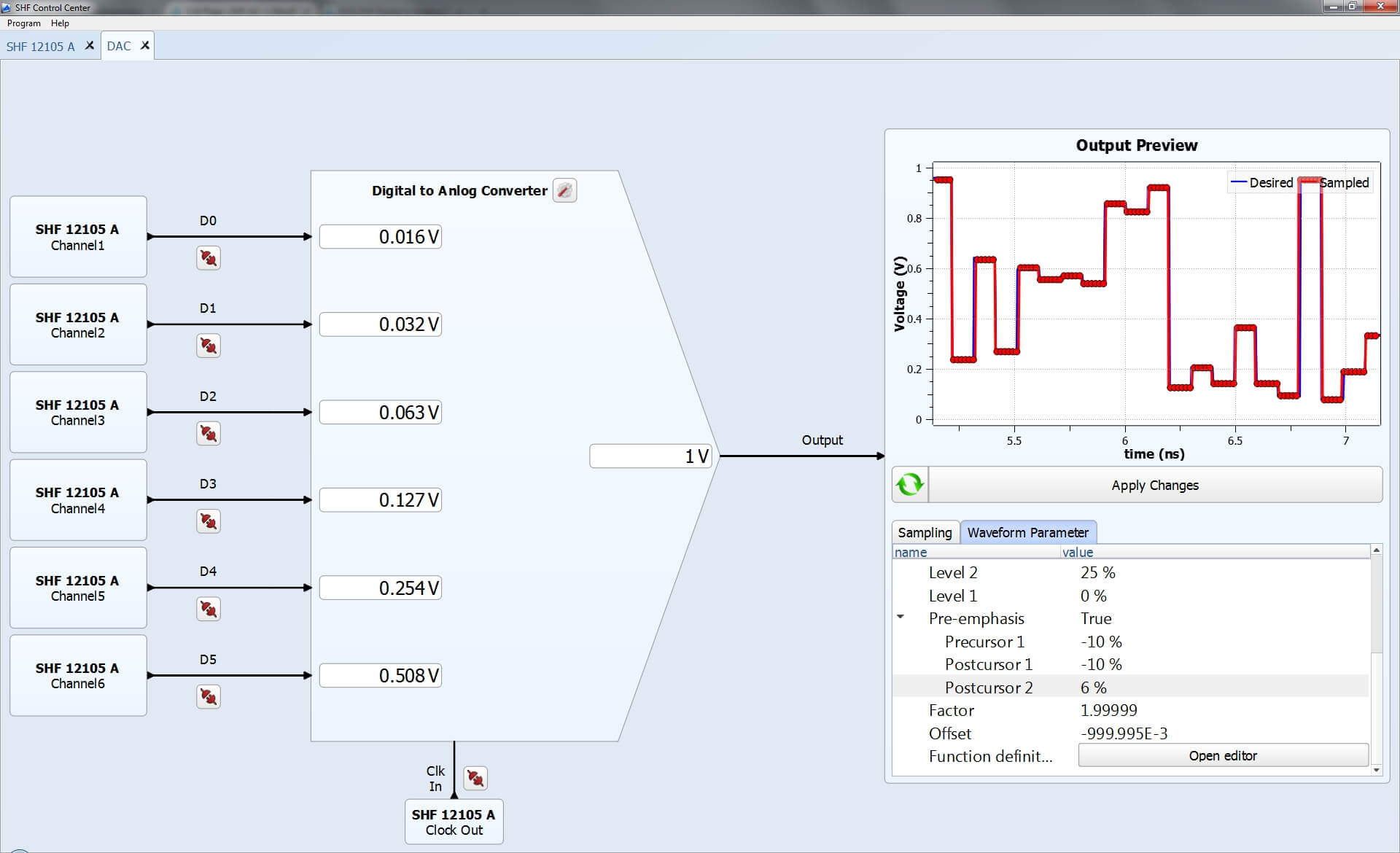
Above screenshot shows how the GUI is used to configure the multi-channel BPG SHF 12105A with a 6-bit DAC to form a PAM4 waveform with non-equal amplitude eye opening and pre-emphasis for device testing requiring some degree of non-linearity compensation.
How can I create an arbitrary waveform?
There are various options to create the waveform:
- Load it from a file
- Select from our library and change the parameters according to your needs
- Use the graphical sequence editor
- Program your waveform in our editor
One more click and the DAC will produce the desired waveform.
What are the benefits of a BPG-based AWG over conventional AWG?
Generally, a Bit Pattern Generator (BPG) has some advantages over an Arbitrary Waveform Generator (AWG):
A. Baud Rate = Sample Rate
BPGs operate very broadband by tuning the input clock frequencies (SHF BPGs work from approximately 5 Gbps up to 64 Gbps). The sample rate of an AWG can be restricted to a narrow band. This becomes particularly critical when data signals (be it NRZ or PAM) are to be produced where the sample rate of the AWG is not an integer multiple of the baud rate of the data signal.
With data signal created by a BPG + DAC architecture, the baud rate and the sample rate can always be identical (1 Sample per Baud), thus no software tricks have to be applied to compensate for fractional sample to baud rate relations.
B. Logical Pattern Generation (No Memory Used)
A BPG can produce some pattern types logically, i.e. not loaded from the memory (most famously, creating NRZ PRBS patterns). This way, the patterns can be very long (up to at least 231-1) and there is no up-load time (which can be quite long for long user defined patterns) as in the case of a conventional AWG relying on user-defined patterns.
In first place one may think that these advantages do only apply to pure BPG and not to an AWG based on a BPG/DAC architecture. For most microwave signals this is correct, however, for some data signals the coding can be done in the BPG hardware, thus the user memory is not used and above advantages do still apply for the signals from the DAC. Some examples are:
1.) Standard PAM
Just by applying standard PRBS signals to the DAC the DAC will create PAM4, PAM8 etc.
2.) Symmetrical unequal PAM4
In case the voltage contribution of the LSB input is exactly half of the voltage contribution of the MSB, the PAM4 signal is fully symmetric, i.e. all three eye heights are the same. This would be the standard setting of the DAC.
If the voltage contribution of the input bits deviates from half, the eye heights won’t be equal anymore. However, it will always remain symmetric. This means, in case the inner eye gets bigger the two outer eyes will be smaller but the two outer eyes will always have the same height. In the SHF DAC GUI, this is defined by the symmetry control.
3.) Non-equal amplitude PAM4
With “non-equal amplitude”, all three eye heights are different. For example, the lowest PAM eye is small, the middle is average and the upper is big (or vice versa). This is quite useful in case the DUT has a non-linear transfer characteristic (e.g. an EA modulator).
With a SHF BPG and a SHF DAC with at least 3 Bits (the more bits you use the finer you can set your different eye heights), the individual level spacing can be set just by a few SHF Control Center clicks as shown below for the case of using a 3-bit DAC.

PAM4 Amplitude Setting
Please note, for this special application, you can leave the BPG in PRBS mode and let the BPG do the recalculation of the patterns in hardware. Thus there are no such AWG drawbacks such as pattern length restriction due to memory size limit, and waiting time when patterns are uploaded. Our architecture can do non-equal amplitude PAM eyes with pattern length up to 231-1.
4.) Pre-Emphasis
A pre-emphasis tap can be set up by generating the same data pattern twice with one being inverted and delayed (or advanced) by one bit before the patterns are added together. Delaying and inverting is a simple task for the multi-channel BPG while still being in PRBS mode. Adding together is done by the DAC. Even the amount of the pre-emphasis can be adjusted by varying the contribution of this input into the DAC.
In case enough bits are available at the DAC, this concept can be easily extended to multi-level signals and/or more pre-/de-emphasis taps.
Again, all this is done by simply generating standard PRBS patterns with the BPG and therefore “the AWG drawbacks” do not apply.
Videos
blank
Equalization of PAM4 signals
56 GBaud PAM4 BER analysis
PAM signal generation at the ECOC 2017
With this DAC and the SHF 616 A PAM4-Multiplexer we show the generation of various types of high speed (56 GBaud and 112 GBaud) PMA4 signals like PAM with pre-emphasis or PAM with unequal eye openings.
Software
blank
SHF Control Center (SCC)
All parts in our current product range of Bit Error Test & Arbitrary Waveform Generation Instruments require the SCC to operate (e.g. the SHF 12106 A BPG). Some obsolete parts of older vintage, however, may require the BCC.
This SHF software is free of charge for the lifetime of your device. The most current version can be downloaded here.
BERT Control Center (BCC)
The BCC may be required to operate some older vintage obsolete parts of the Bit Error Test & Arbitrary Waveform Generation Instruments section.
Discontinued Products
blank
Discontinued Pattern Generators & Error Analyzers
| P/N | Type |
|---|---|
| SHF 11100 A | 6 … 50 Gbps Error Analyzer (OC-768) |
| SHF 11100 B | 6 … 56 Gbps Error Analyzer (OC-768) |
| SHF 11102 A | 3 … 28 Gbps Error Analyzer |
| SHF 11110 A | 40 Gbps Error Analyzer (OC-768) |
| SHF 11122 A | 40 Gbps Error Analyzer (OC-768) |
| SHF 11125 A | 2x 32 Gbps Error Analyzer |
| SHF 12100 A | 6 … 50 Gbps Pattern Generator (OC-768) |
| SHF 12100 B | 6 … 56 Gbps Pattern Generator (OC-768) |
| SHF 12101 A | 1.5 … 12.5 Gbps Pattern Generator (OC-192) |
| SHF 12102 A | 3 … 28 Gbps Pattern Generator |
| SHF 12103 A | 32 Gbps Quad- & 56 Gbps Dual-Channel Bit Pattern Generator (BPG) |
| SHF 12104 A | Multi-Channel 64 Gbps Bit Pattern Generator (BPG) |
| SHF 12105 A | Eight-Channel 64 Gbps Bit Pattern Generator (BPG) |
| SHF 12110 A | Multi-Band Bit Pattern Generator (OC-768) |
| SHF 12122 A | Multi-Band Bit Pattern Generator (OC-768) |
| SHF 12124 A | Dual-Channel 32 Gbps Bit Pattern Generator |
Discontinued Optical Transmitters
| P/N | Type |
|---|---|
| SHF 5003 DPSK | E/O DPSK Transmitter |
| SHF 5003 RZ | RZ/NRZ Optical Transmitter |
| SHF 5003 NRZ | 50 GBit/s Optical Transmitter |
| SHF 46100 A | E/O conversion module |
| SHF 46120 A | ASK Optical Transmitter (E/O Converter) |
| SHF 46120 B | ASK & PAM Optical Transmitter (E/O Converter) |
| SHF 46120 C | ASK & PAM Optical Transmitter (E/O Converter) |
| SHF 46121 B | ASK & PAM Optical Transmitter (E/O Converter) |
| SHF 46121 C | ASK & PAM Optical Transmitter (E/O Converter) |
| SHF 46123 A | ASK & PAM Optical Transmitter (E/O Converter) |
| SHF 46210 B | 40 Gbps Optical multiformat DPSK Transmitter (E/O Converter) |
| SHF 46210 C | 40 Gbps Optical multiformat DPSK Transmitter (E/O Converter) |
| SHF 46211 A | 10 Gbps Optical multiformat DPSK Transmitter (E/O Converter) |
| SHF 46212 A | 40 Gbps Optical Duobinary Transmitter (E/O Converter) |
| SHF 46213 A | 40 Gbps DQPSK Optical Transmitter (E/O Converter) |
| SHF 46213 C | 40 Gbps DQPSK Optical Transmitter (E/O Converter) |
| SHF 46213 D | QPSK and QAM Optical Transmitter (E/O Converter) |
| SHF 46214 C | 100 Gbps DQPSK Optical Transmitter (E/O Converter) |
| SHF 46214 D | 110 Gbps DQPSK Optical Transmitter (E/O Converter) |
| SHF 46215 A | 128 Gbps DP-QPSK Optical Transmitter (E/O Converter) |
| SHF 46215 B | 132 Gbps (DP-QPSK) and 264 Gbps (DP-QAM) Optical Transmitter |
Discontinued Optical Receivers
| P/N | Type |
|---|---|
| SHF 5008 DPSK | O/E DPSK Receiver |
| SHF 47100 A | Optical Receiver |
| SHF 47100 B | Optical Receiver |
| SHF 47210 A | 39.8 to 43 Gbps DPSK Receiver w. single ended output |
| SHF 47211 A | 9.9 to 10,8 Gbps DPSK Receiver w. single ended output |
| SHF 47214 A | 48 to 55 Gbps DPSK Receiver w. single ended output |
| SHF 47215 C | 26 to 30 Gbps DPSK Receiver w. single ended output |
Discontinued 10000 Series Mainframes
| P/N | Type |
|---|---|
| SHF 10000 B | Large Mainframe |
| SHF 10000 C | Large Mainframe |
| SHF 10000 D | Large Mainframe |
| SHF 10001 A | Small Mainframe |
| SHF 10001 B | Small Mainframe |
Discontinued Amplifier Instruments
| P/N | Type |
|---|---|
| SHF 58211 A | Dual Amplifier |
| SHF 58214 A | Multi-Channel Amplifier |
| SHF 58215 A | Multi-Channel Amplifier |
Discontinued Arbitrary Waveform Generation Products
| P/N | Type |
|---|---|
| SHF 19120 A | 2.85 GSa/s AWG + 4x 10.3 Gbps BPG |
| SHF 19120 B | 2.85 GSa/s AWG + 4x 10.3 Gbps BPG |

